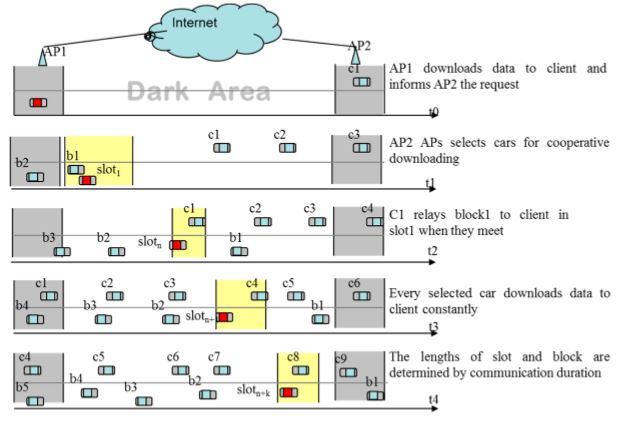ABSTRACT
Cooperative downloading is one of the effective methods to improve the amount of downloaded data in vehicular adhoc networking (VANET). However, the poor channel quality and short encounter time bring about a high packet loss rate, which decreases transmission efficiency and fails to satisfy the requirement of high quality of service (QoS) for some applications.
Digital fountain code (DFC) can be utilized in the field of wireless communication to increase transmission efficiency. For cooperative forwarding, however, processing delay from frequent coding and decoding as well as single feedback mechanism using DFC cannot adapt to the environment of VANET. In this paper, a cooperative downloading method for VANET using concatenated DFC is proposed to solve the problems above.
The source vehicle and cooperative vehicles encodes the raw data using hierarchical fountain code before they send to the client directly or indirectly. Although some packets may be lost, the client can recover the raw data, so long as it receives enough encoded packets. The method avoids data re-transmission due to packet loss. Furthermore, the concatenated feedback mechanism in the method reduces the transmission delay effectively. Simulation results indicate the benefits of the proposed scheme in terms of increasing amount of downloaded data and data receiving rate.
RELATED WORK
Cooperative downloading in vehicular networks was first introduced by Nandan et al. As a part of the protocol-SPAWN for cooperative content retrieval and sharing among users aboard vehicles. MobTorrent improved the amount of downloaded data. The study ignored the packet loss rate and the client had to obtain the loss packets in the next hot spot. Dongyao Jia et al. Proposed a re-transmission scheme to reduce the packet loss rate at the cost of more re-transmission time, which brought about low throughput. Yuchen Wu et al.
Proposed to exploit trajectory prediction to improve data delivery. However, they did not discuss the solution for the loss of the packets. A compensation method was proposed in. In this method, the loss packets were relayed in cooperative vehicles in order to reduce the packet loss rate. Furthermore, Liu proposed the strategy of data uploading in a VANET-based mobile cloud service for enlarging the communication area and reducing the delay of remote transmission.
THE METHOD OF COOPERATIVE DOWNLOADING
As shown in Figure 2, the vehicles entered and left the AP communication area at different times as well as encountered the client in the dark area (DA) at different times and areas. Therefore, AP could choose a group vehicles to relay data to the client in the DA, as shown at t1–t4 in Figure 2. Due to the limited communication area of the vehicles (about 300 m using DSRC), the amount of data the cooperative vehicles carried was decided by the encountering time with the client.
According to previous research, traffic conforms to Poisson distribution. When λ = 5, up to 20% vehicles can act as the helpers. Transmission collision will take place if more than 20% vehicles provide cooperative downloading services. Therefore, which vehicles are selected to provide cooperative downloading services is closely related to system throughput. According to the characteristic of VANET, we propose a cooperative downloading strategy based on dynamic slots. In this strategy, the DA is divided into several slots according to the encountering time between the vehicles and the client.
PERFORMANCE EVALUATION
The experiment scenario is shown in Figure 4. The coverage area of AP is set to 800 m, while the communicationradiusofvehiclesissetto300maccordingto. We roughly assume 1s as overhead to set up connection, 150 Kbytes/s, 200 Kbytes/s, and 50 Kbytes/s as the downloading speed of the APs, and SDCD (same direction cooperative downloading) and ODCD (opposite direction cooperative downloading) driving vehicles, respectively. The range of vehicle speed is set from 60 km/h to 120 km/h. p is defined as the changing speed rate in accordance with log-normal distribution.
Figure 5 illustrates the result of when the speeds of vehicles are from 60 km/h to 120 km/h and p = 20%, assuming that the traffic arrival follows a Poisson distribution with a rate of one vehicle per λ seconds (λ = 10). Obviously, PLRs of the four methods rise with the increase in the vehicle speed. DSRelay does not employ DFC. Therefore, the PLR is higher compared with the other methods. Interestingly, when the vehicle speed is 120 km/h, the PLR arrives at 25%. In contrast, the other methods using DFC have a lower rate. Their PLRs keep below 5% when the speed changes from 60 to 120 km.
CONCLUSIONS
In this paper, we propose the cooperative downloading method for VANET using DFC to increase the amount of downloaded data and enable the transmission to be more robust in a vehicular environment. The requested data is not only directly transferred between an access point and a passing vehicle, but further vehicles running in DA are being used as relays. By making use of DFC, the client can recover the raw data once it receives enough encoded packets from the source vehicle or cooperative vehicles.
Besides, the cascading encoding mechanism avoids encoding and decoding processes in relay nodes, which reduces the compute complexity. Simulation results indicate that DDFC can reduce packet loss rate efficiently, while the amount of downloaded data increases by about 20% compared with other DFC methods. It implies that the approach is more robust to occasional packet losses, especially in a highway scenario with low coverage and a high communication cost of cellular systems. In future work, we will continue to research the influence of multi-clients cooperative downloading in multi-channels using distributed DFC.
Source: University of Petroleum
Authors: Jianhang Liu | Wenbin Zhang | Qi Wang | Shibao Li | Haihua Chen | Xuerong Cui | Yi Sun


